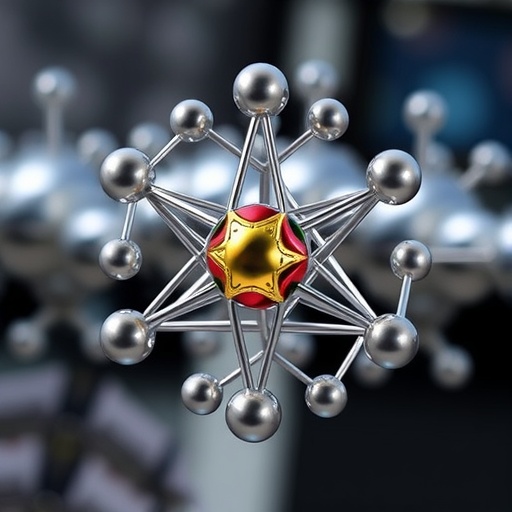In the relentless pursuit of lighter, stronger, and more sustainable materials, especially for the transportation industry, a longstanding mystery has puzzled researchers: how do some plastics bond directly to metals without any adhesive? A team of scientists at Osaka Metropolitan University has now shed unprecedented light on this phenomenon. Their breakthrough study, employing all-atom molecular dynamics simulations, reveals how the intricate dance between polymer chemistry and metal surface properties governs adhesion at an atomic scale. This fundamental insight lays the groundwork for creating durable hybrid materials that combine the toughness of metal with the flexibility and lightness of plastics, revolutionizing vehicle design and efficiency.
Understanding why certain plastics stick effectively to metals while others do not requires an in-depth look at the molecular scale. The Osaka Metropolitan researchers focused on polyamides (PAs), commonly known as nylons, which are frequently used plastics known for their mechanical resilience and chemical versatility. They explored two different polyamide types: PA6, characterized by a flexible aliphatic backbone, and PAMXD6, notable for its rigid aromatic ring structure. These polymers were studied in combination with alumina surfaces, a common metal oxide found in aluminum alloys, which serves as a representative model for metal substrates.
A crucial factor in this polymer-metal interaction is the chemistry of the alumina surface, specifically whether it terminates with hydroxyl groups (OH-terminated) or remains non-hydroxylated. This termination dictates the chemical environment that polymer chains encounter upon contact. Hydroxylated surfaces present reactive sites that can form hydrogen bonds and other interactions with polymer chain segments, whereas non-hydroxylated surfaces offer a less interactive interface. Through simulations, the team categorized polymer chain sections into “trains,” regions adsorbed flat on the surface; “loops,” non-adsorbed segments spanning between trains; and “tails,” the free ends extending away from the surface.
Simulating tensile strain applied to the polymer-alumina interface allowed the researchers to probe the mechanical properties of these bonds down to atomic rearrangements—a phenomenon known as yielding. Yielding marks a critical threshold where irreversible changes occur in the interface structure, affecting long-term durability. Before yielding, the mechanical response is governed primarily by the intrinsic chemical composition of the polymer. The aromatic PAMXD6 chains exhibit higher stiffness and a greater ability to resist deformation compared to the more flexible PA6, indicating that polymer backbone rigidity plays a major role in elastic behavior.
However, the picture shifts dramatically after yielding. On hydroxylated alumina surfaces, PAMXD6 chains tend to detach from the surface, a process called desorption, indicating weaker post-yield adhesion. Contrarily, the PA6 polymer shows a remarkable ability to reconfigure its conformation: loops transform into stretched tails, which maintain intimate contact with the surface and prevent full detachment. This adaptability highlights how flexible polymer chains can sustain adhesion under stress via dynamic restructuring at the interface. On non-hydroxylated surfaces, both polymers retain solid attachment through persistent trains and loops, illustrating the pivotal role surface chemistry plays in adhesion stability.
These findings not only identify the chemical-functional relationship that dictates metal-polymer adhesion strength but also have profound practical implications. By understanding the interplay between polymer conformational dynamics and surface termination, materials scientists can rationally design polymer-metal interfaces with targeted performance attributes. This approach reduces reliance on costly and time-consuming trial-and-error experiments traditionally used in developing metal-plastic hybrids. Selecting specific polymer chemistries and applying appropriate surface treatments can optimize joint strength, resilience, and longevity in structural applications.
The implications extend far beyond adhesion science. Lightweight polymer-metal hybrid materials are game-changers for reducing vehicle mass, enhancing fuel efficiency, and ultimately lowering emissions—a cornerstone of sustainable transportation. With carbon neutrality becoming a global mandate, these material innovations align perfectly with environmental goals. The research conducted by Osaka Metropolitan University represents a vital step toward integrated, mechanism-based design strategies that will unlock new performance horizons for automotive, aerospace, and consumer electronics industries.
This breakthrough was achieved through the sophisticated use of computational molecular dynamics simulations, a powerful method that provides atomic-level resolution of materials behavior unattainable by traditional experimental techniques alone. Such simulations enable researchers to visualize and quantify not only static structures but also dynamic processes, such as chain movement and bond breakage, under realistic conditions including applied mechanical load. This virtual microscope approach accelerates material discovery and elucidates fundamental phenomena inherent to complex hybrid interfaces.
Takuya Kuwahara, the study’s lead author, emphasized the significance of their findings in understanding and controlling adhesive mechanisms at the molecular scale. Their research confirms that the intrinsic stiffness of polymer backbones and the chemical composition of metal surfaces collectively dictate adhesion behavior before and after materials yield under stress. They demonstrated that flexible polymers are better suited to sustain bonding on reactive hydroxylated surfaces through molecular reorganization, whereas rigid polymers perform better on less reactive, non-terminated surfaces.
Overall, this groundbreaking study provides a comprehensive, hierarchical view of polymer-alumina bonding across multiple length scales, bridging chemistry, mechanics, and molecular physics. The insights gained pave a clear path for the next generation of polymer-metal hybrid materials that are not only stronger and lighter but also more sustainable. As industries strive to meet ambitious emission reduction targets, the ability to engineer joints explicitly from a fundamental understanding of microscopic adhesion mechanisms represents a transformative advance.
In conclusion, Osaka Metropolitan University’s research heralds an exciting era wherein molecular simulations translate into tangible, real-world materials innovation. The synergy between polymer design and surface engineering, grounded in atomic-level comprehension, will enable lightweight, durable, and environmentally responsible hybrid structures critical for the future of transportation and beyond. This work serves as a clarion call for concerted multidisciplinary efforts to harness chemistry and mechanics in crafting the materials of tomorrow.
Subject of Research: Not applicable
Article Title: Chemical Functionalities Govern Polyamide–Alumina Adhesion through Local Conformational Dynamics
News Publication Date: 10-Nov-2025
References: DOI: 10.1038/s43246-025-00977-y
Image Credits: Osaka Metropolitan University
Keywords
Polymer-metal adhesion, molecular dynamics simulation, polyamide, alumina surface, polymer conformation, material interface, sustainable materials, lightweight composites, vehicle materials, molecular mechanics, surface chemistry, hybrid materials




